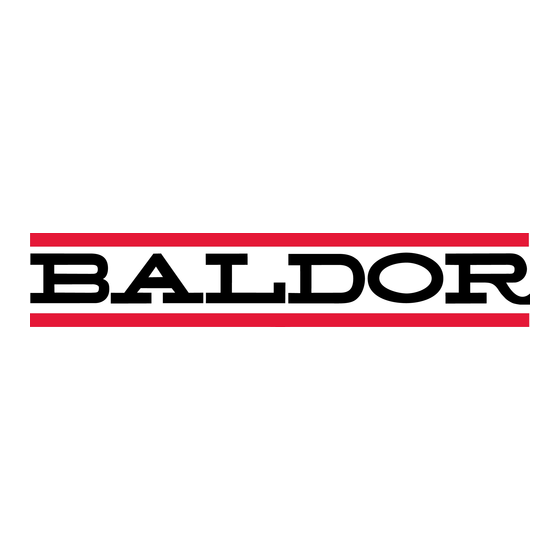Summary of Contents for Baldor ODP series
- Page 1 Integral Horsepower AC Induction Motors ODP, WPI, WPII Enclosure TEFC Enclosure Explosion Proof Installation & Operating Manual 2/07 MN400...
-
Page 3: Table Of Contents
Table of Contents Section 1 General Information ................1‐1 Overview . -
Page 4: General Information
Section 1 General Information ii Table of Contents MN400... -
Page 5: Overview
Baldor motor and the problem encountered. 3. Baldor will not pay the cost of removal of any electric motor from any equipment, the cost of delivery to Fort Smith, Arkansas or a Baldor Authorized Service Center, or the cost of any incidental or consequential damages resulting from the claimed defects. -
Page 6: Safety Notice
Safety Notice This equipment contains high voltage! Electrical shock can cause serious or fatal injury. Only qualified personnel should attempt installation, operation and maintenance of electrical equipment. Be sure that you are completely familiar with NEMA publication MG‐2, safety standards for construction and guide for selection, installation and use of electric motors and generators, the National Electrical Code and local codes and practices. - Page 7 NEMA MG1 and MG2 standards to avoid equipment damage. If you have any questions or are uncertain about any statement or procedure, or if you require additional information please contact your Baldor distributor or an Authorized Baldor Service Center. MN400...
-
Page 8: Receiving
Section 1 General Information Receiving Each Baldor Electric Motor is thoroughly tested at the factory and carefully packaged for shipment. When you receive your motor, there are several things you should do immediately. Observe the condition of the shipping container and report any damage immediately to the commercial carrier that delivered your motor. -
Page 9: Installation & Operation
The standard motor base is designed for horizontal or vertical mounting. Adjustable or sliding rails are designed for horizontal mounting only. Consult your Baldor distributor or authorized Baldor Service Center for further information. -
Page 10: Doweling & Bolting
After proper alignment is verified, dowel pins should be inserted through the motor feet into the foundation. This will maintain the correct motor position should motor removal be required. (Baldor motors are designed for doweling.) Drill dowel holes in diagonally opposite motor feet in the locations provided. - Page 11 Section 1 General Information Figure 2‐2 Typical Motor Performance VS Voltage Variations Maximum Full ‐Load Torque Current Full ‐Load Power Current Factor Efficiency Efficiency Power Maximum Factor Torque Voltage Variations (%) MN400 Installation & Operation 2‐3...
-
Page 12: First Time Start Up
A much greater amount of heat is produced by each acceleration or jog than by the same motor under full load. If it is necessary to repeatedly start or jog the motor, it is advisable to check the application with your local Baldor distributor or Baldor Service Center. -
Page 13: Maintenance & Troubleshooting
10500 Hrs. Relubrication intervals are for ball bearings. For vertically mounted motors and roller bearings, divide the relubrication interval by 2. ** For motors operating at speeds greater than 3600 RPM, contact Baldor for relubrication recommendations. MN400 Maintenance & Troubleshooting 3‐1... - Page 14 Table 3‐2 Service Conditions Severity of Service Hours per day Ambient Temperature Atmospheric of Operation Maximum Contamination Standard 40° C Clean, Little Corrosion Severe 16 Plus 50° C Moderate dirt, Corrosion Extreme 16 Plus >50° C* or Severe dirt, Abrasive dust, Corrosion, Heavy Class H Insulation Shock or Vibration <-29 °...
-
Page 15: Relubrication Procedure
Relubrication Procedure Be sure that the grease you are adding to the motor is compatible with the grease already in the motor. Consult your Baldor distributor or an authorized service center if a grease other than the recommended type is to be used. -
Page 16: Troubleshooting Chart
Excessive humming High Voltage. Check input line connections. Eccentric air gap. Have motor serviced at local Baldor service center. Motor Over Heating Overload. Compare actual amps Locate and remove source of excessive friction in (measured) with nameplate rating. - Page 17 Suggested bearing and winding RTD setting guidelines Most large frame AC Baldor motors with a 1.15 service factor are designed to operate below a Class B (80°C) temperature rise at rated load and are built with a Class H winding insulation system. Based on this low temperature rise, RTD (Resistance Temperature Detectors) settings for Class B rise should be used as a starting point.
- Page 18 3‐6 Maintenance & Troubleshooting MN400...
- Page 19 Baldor District Offices Baldor District Offices Baldor District Offices...
- Page 20 BALDOR ELECTRIC COMPANY World Headquarters P.O. Box 2400 Fort Smith, AR 72901-2400 (479) 646-4711 Fax (479) 648-5792 www.baldor.com © Baldor Electric Company Printed in USA MN400 2/07...




Need help?
Do you have a question about the ODP series and is the answer not in the manual?
Questions and answers